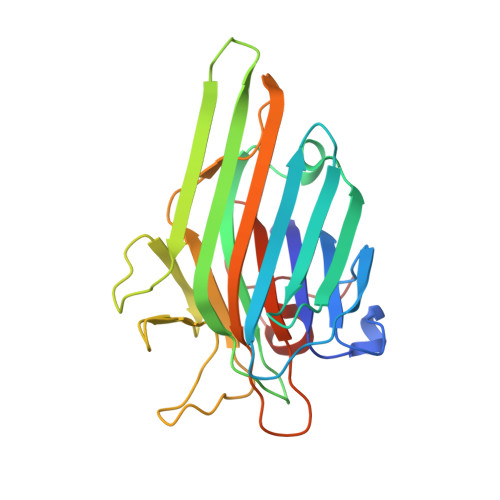Structural Studies of an Anti-Inflammatory Lectin from Canavalia boliviana Seeds in Complex with Dimannosides.
Bezerra, G.A., Viertlmayr, R., Moura, T.R., Delatorre, P., Rocha, B.A., do Nascimento, K.S., Figueiredo, J.G., Bezerra, I.G., Teixeira, C.S., Simoes, R.C., Nagano, C.S., de Alencar, N.M., Gruber, K., Cavada, B.S.(2014) PLoS One 9: e97015-e97015
- PubMed: 24865454
- DOI: https://doi.org/10.1371/journal.pone.0097015
- Primary Citation of Related Structures:
4K1Y, 4K1Z, 4K20, 4K21 - PubMed Abstract:
Plant lectins, especially those purified from species of the Leguminosae family, represent the best-studied group of carbohydrate-binding proteins. Lectins purified from seeds of the Diocleinae subtribe exhibit a high degree of sequence identity notwithstanding that they show very distinct biological activities. Two main factors have been related to this feature: variance in key residues influencing the carbohydrate-binding site geometry and differences in the pH-dependent oligomeric state profile. In this work, we have isolated a lectin from Canavalia boliviana (Cbol) and solved its x-ray crystal structure in the unbound form and in complex with the carbohydrates Man(α1-3)Man(α1-O)Me, Man(α1-4)Man(α1-O)Me and 5-bromo-4-chloro-3-indolyl-α-D-mannose. We evaluated its oligomerization profile at different pH values using Small Angle X-ray Scattering and compared it to that of Concanavalin A. Based on predicted pKa-shifts of amino acids in the subunit interfaces we devised a model for the dimer-tetramer equilibrium phenomena of these proteins. Additionally, we demonstrated Cbol anti-inflammatory properties and further characterized them using in vivo and in vitro models.
Organizational Affiliation:
Institute of Molecular Biosciences, University of Graz, Graz, Austria.

















